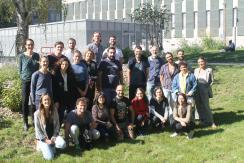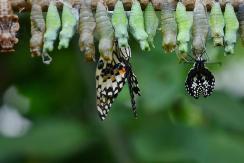COEVOL Multi-Scale Coevolution
Living systems are highly integrated, with a multitude of levels of organization, from molecular and intra-cellular scales to ecosystems. Complex organisms are themselves consortia of macro- and micro-organisms, which work together with their host to build the individual. Yet, each of these organisms can function and evolve in the short term according to its own logic, possibly in conflict with other higher or lower levels, or with other time scales. The once common idea among evolutionists that natural selection results in organisms perfectly adapted to their environment is now severely undermined. Not only because, as the Red Queen explains to Alice, one has to run relentlessly to keep its place in a changing environment, or because past evolutionary history and chance constrain the possibilities of present adaptation, but also because different levels of selection have interests that are generally difficult to reconcile.
Multi-scale coevolution resets classical questions in evolutionary biology
One example, of particular interest is the question of the source of heritable variations. The phenotype of organisms in a population is influenced not only by variations in their nuclear and mitochondrial genomes, the dynamics of which is the object of population genetics, but also more and more patently by the consortium of microbes and genetic elements that constitute its microbiome and virome. The hologenome designates this complex assembly of genetic materials, which obey different rules of transmission and different evolutionary strategies. The ability of symbionts to manipulate host phenotypes or to interfere with each other influences the evolutionary dynamics of all players in ways that are yet poorly understood. In addition, new questions arise, such as the importance of co-adaptation in these systems and their consequences in maintaining cohesive biological systems.
- Symbiosis: a response to and a source of divergent selection
Using a variety of approaches combining experimental evolution, genomic, functional, phenotypic and behavioral data, we aim to test whether symbiosis facilitates diversification and to characterize the underlying microevolutionary processes.
- Ecological networks of horizontal gene transfer
We develop original methods to detect gene transfer and we investigate the factors that influence the routes of gene transfers among microbes but also among insects.
- The interplay between symbiosis, infection and immunity and its evolutionary consequences
We try to understand the intimate interaction of hosts with pathogens, symbionts and transposable elements and how it affects the extended phenotype of the host.
- Transgenerational inheritance and environment changes
We try to decipher the molecular mechanisms that underlie rapid adaptation to environment and to test for transgenerational inheritance of fitness traits.
- Intragenomic conflicts and demography
We are developing models to test whether changes in the demography of the host affect the dynamics of transposable elements.
- The determinism of phenotypic convergence
We study the genomic basis of convergent phenotypic evolution in particular in the case of animals and plants adaptation to increasing temperature and decreasing water.
- Reconciling the tree of life
We develop phylogenetic methods for “reconciling” gene/species or host/symbiont histories and use these methods to explore the bulk of extinct or undescribed species and the history of association of symbiotic microbes with their hosts.
Integrating methods
The methods we use to tackle the questions raised by multi-scale co-evolution extend from theory, modelling and simulation to big data analysis, lab (notably on insects), and to a lesser extent, field activities.
Implication of research, responsibility of researchers and citizen sciences
From our research (some of which have immediate consequences in health, agriculture and ecology) and our concerns about the responsibility of scientists in society, we are committed to promote an “implicative” research. The implicative position means that we try to work on the link between science and society, not only through a one-way communication, applying or explaining our science, but also favoring early discussions on research projects, that may influence our research directions.
Publications
Display of 601 to 630 publications on 709 in total
A computational prediction of isochores based on hidden Markov models
Gene . 385 : 41-49
Journal article
see the publicationArtifical transfer and morphological description of virus particles associated with superparasitism behaviour in a parasitoid wasp.
Journal of Insect Physiology . 52 ( 11-12 ) : 1202-1212
Journal article
see the publicationSuperparasitism evolution: adaptation or manipulation?
The American Naturalist . 167 ( 1 ) : E1-E22
DOI: 10.1086/498398
Journal article
see the publicationThe virus infecting the parasitoid Leptopilina boulardi exerts a specific action on superparasitism behaviour
Parasitology . 132 : 747-756
Journal article
see the publicationEfficient Likelihood Computations with Nonreversible Models of Evolution
Systematic Biology . 55 ( 5 ) : 756-768
Journal article
see the publicationOngoing loss of the tirant transposable element in natural populations of Drosophila simulans
Gene . 375 : 54-62
Journal article
see the publicationDifferences in genome size between closely related species: the Drosophila melanogaster species subgroup.
Molecular Biology and Evolution . 23 ( 1 ) : 162-7
Journal article
see the publicationAgeing and the evolution of female resistance to remating in seed beetles
Biology Letters . 2 : 62-64
Journal article
see the publicationUnicoloniality recognition and genetic differentiation in a native Formica ant
Journal of Evolutionary Biology . 19 : 2031-2039
Journal article
see the publicationUV-Targeted Dinucleotides Are Not Depleted in Light-Exposed Prokaryotic Genomes
Molecular Biology and Evolution . 23 : 2214-2219
Journal article
see the publicationA Newly Discovered Virus Manipulates Superparasitism Behavior in a Parasitoid Wasp
Insect Symbiosis . 2 : 119-139
Book chapter
see the publicationEffect of temperature on Wolbachia density and impact on cytoplasmic incompatibility
Parasitology . 132 : 49-56
Journal article
see the publicationDifferences in Genome Size Between Closely Related Species : The Drosophila melanogaster Species Subgroup
Molecular Biology and Evolution . 23 : 162-167
Journal article
see the publicationDifferences in genom size between closely related species : the drosophila melanogaster species subgroup.
Molecular Biology and Evolution . ( 23 ) : 162-167
Journal article
see the publicationGlobal trends of whole-genome duplications revealed by the ciliate Paramecium tetraurelia.
Nature . 444 ( 7116 ) : 171-8
DOI: 10.1038/nature05230
Journal article
see the publicationSynonymous codon usage and its potential link with optimal growth temperature in prokaryotes.
Gene . 385 : 128-136
Journal article
see the publicationRevisiting the directionnal mutation pressure theory : The analysis of a particular genomic structure in Leishmania major
Gene . 385 : 28-40
Journal article
see the publicationIncrease of the Behavioral Response to Kairomones by the Parasitoid Wasp Leptopilina heterotoma Surviving Insecticides
Archives of Environmental Contamination and Toxicology . 49 : 186-191
Journal article
see the publicationEvaluation des effets sublétaux d'insecticides sur des insectes auxiliaires entomophages.
Programme national d'écotoxicologie: avancées récentes .
Book chapter
see the publicationSarment: Python modules for HMM analysis and partitioning of sequences
Bioinformatics . 21 : 3427-3428
Journal article
see the publicationMultiple infections and diversity of cytoplasmic incompatibility in a haplodiploid species
Heredity . 94 : 187-192
Journal article
see the publicationAn efficient procedure for purification of the obligate intracellular Wolbachia pipientis and representative amplification of its genome by multiple displacement amplification
Applied and Environmental Microbiology . 71 : 6910-6917
Journal article
see the publicationTransposable elements in mosquitoes
Cytogenetics and Genome Research . 110 : 500--509
Journal article
see the publicationEvolutionary origins of genomic repertoires in bacteria
PLoS Biology . 3 : 0807-0814
Journal article
see the publicationIs genome size influenced by colonization of new environments in dipteran species ?
Molecular Ecology . 14 : 869-878
Journal article
see the publicationNew regulatory regions of Drosophila 412 retrotransposable element generated by recombination
Molecular Biology and Evolution . 22 : 747-757
Journal article
see the publicationAdaptive male effects on female ageing in seed beetles
Proceedings of the Royal Society B: Biological Sciences . 272 : 2485-2489
Journal article
see the publicationWolbachia requierement for oogenesis : occurence within the genus Asobara (Hynoptera, Braconidae) and evidence for intraspecific variation in A. tabida.
Heredity . 95 : 394-400
Journal article
see the publication

